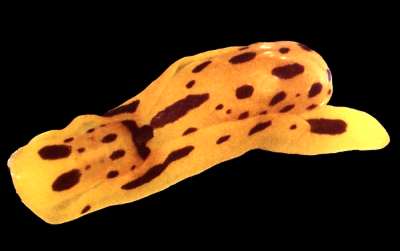
Siphopteron michaeli
(Gosliner & Williams, 1988)
Order: CEPHALASPIDEA
Superfamily: PHILINOIDEA
Family: Gastropteridae
DISTRIBUTION
Known only from Reunion Island, Indian Ocean
PHOTO
Reunion Island, Indian Ocean. Depth: 50 cm. Length: 3 mm. under dead coral. Photographer: Maurice Jay
The animal is uniformly yellow or yellow-orange, with large elongate dark brown spots on the head shield and visceral hump, and outer side of the parapodia. There is one large elongate spot in the dorsal midline of the posterior foot. Until more specimens are discovered it is not possible to say whether the spots are arranged in a particular pattern although it sems as though in the specimens photographed here there the posterior edge of the headshield and the siphon are dark brown, and the markings of the head shield appear to be arranged symmetrically.
The posterior end of the headshield is folded to form a central siphon with a median crest. There is no flagellum present on the visceral hump. It grows to approximately 5mm in length.
-
Gosliner, T.M. & Williams, T. M. (1988) A new species of Gastropteron (Gastropoda: Opisthobranchia) from Reunion Island, Indian Ocean. The Veliger, 30(3), 315-318.
-
Gosliner, T.M. (1989) Revision of the Gastropteridae (Opisthobranchia: Cephalaspidea) with descriptions of a new genus and six new species. The Veliger, 32(4): 333-381. (Figs 1-32)
Rudman, W.B., 2005 (September 18) Siphopteron michaeli (Gosliner & Williams, 1988). [In] Sea Slug Forum. Australian Museum, Sydney. Available from http://www.seaslugforum.net/find/siphmich
Related messages
Re: Siphopteron michaeli - Feeding?
April 17, 2008
From: Hugues Flodrops
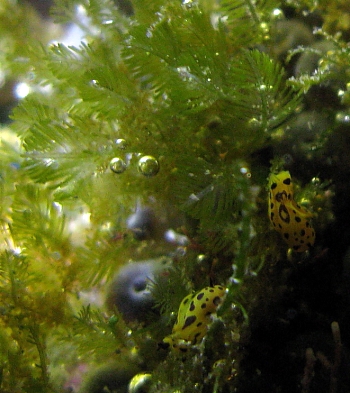
Concerning message #18157:
Dear Bill,
Last time I found Siphopteron michaeli hiding on Padina: brown algae.
This time, I found two others apparently feeding on green algae. Could Caulerpa sertularoides be the species of this algae?
Locality: Etang-Salé, 1metre, Reunion Island, Indian Ocean, 12 April 2007, muddy. Length: 2-3 mm. Photographer: Hugues Flodrops.
These Siphopteron michaeli are quite small (2-3 mm) so I can't see the shape of the teeth, excuse me.
Regards and thanks for your comments.
Hugues.
hugues.flodrops@wanadoo.fr
Flodrops, H., 2008 (Apr 17) Re: Siphopteron michaeli - Feeding?. [Message in] Sea Slug Forum. Australian Museum, Sydney. Available from http://www.seaslugforum.net/find/21532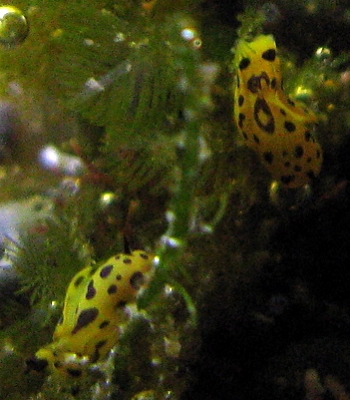
Dear Hugues,
Thanks for the observation. From the shape of their teeth and the anatomy of their alimentary canal I am sure gastropterids are carnivorous. They are often found in association with certain sponges which led to the belief that they are sponge-feeders, but again their anatomy does not support this and none of their relatives are sponge feeders.
I suspect you are finding this species in algae because their actual food is also living there. My guess is that they feed on small flatworms. If they are eating flatworms we will need to catch them in the act, because flatworms have no indigestible hard parts for us to find in the gut of Siphopteron if we went looking there. Although not the greatest problem facing humanity, I would really love to know what these animals feed on.
Best wishes,
Bill Rudman
Siphopteron michaeli from Reunion Island
January 30, 2007
From: Hugues Flodrops
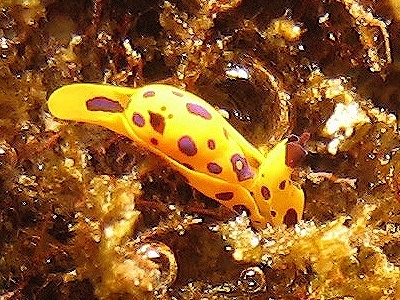
Dear Bill,
Here are two other photos of a very small seaslug known only from Reunion Is. These pictures looks like the ones in the Gosliner & Williams (1988) which are copied lower right. I saw four specimens on the same dive, living in Padina, a brown algae.
Locality: Rocky coast, 0,30 metres, Etang-Salé, Indian Ocean, 19 and 21 january 2007. Length: About 3 mm. Photographer: Hugues Flodrops.
-
Gosliner, T.M. & Williams, T. M. (1988) A new species of Gastropteron (Gastropoda: Opisthobranchia) from Reunion Island, Indian Ocean. The Veliger, 30(3), 315-318.
Hugues.
hugues.flodrops@wanadoo.fr
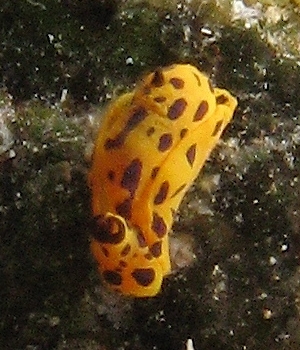
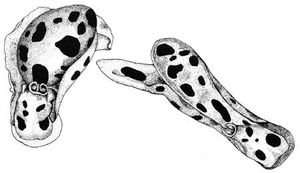
Thanks Hugues,
It looks as though this species is fairly consistent in colour pattern
Best wishes,
Bill Rudman
Re: Siphopteron michaeli from Reunion Island
November 14, 2006
From: Hugues Flodrops
Concerning message #18157:
Dear Bill,
For the story about Gastropteron or Siphopteron, a detail concerning picture 18157: we can see one siphon at the posterior end of the head-shield and so we can surely placed it in Siphopteron.
Thanks and best regards.
Hugues.
hugues.flodrops@wanadoo.fr
Flodrops, H, 2006 (Nov 14) Re: Siphopteron michaeli from Reunion Island. [Message in] Sea Slug Forum. Australian Museum, Sydney. Available from http://www.seaslugforum.net/find/18337Dear Hugues,
Thanks for letting me know. The presence of a siphon is not in itself a character of Siphopteron. The main characters of Siphopteron are the prominent 'crest' along the midline of the siphon, a reduced number of lateral teeth in the radula and some penial structures. Most gastropterids have a siphon, which in its basic shape is formed from the enrolling of the median part of the posterior haead shield. You can see this illustrated quite well in many of the photos of Gastropteron chacmol.
The reason I initially called this Gastropteron michaeli on the Forum was because I thought the paper in which Terry Gosliner named this species was after the revision in which he named the new genus Siphopteron, so I didn't check the detail in his revision to see what genus he had placed it in. I have no issue with it being a Siphopteron, I just made a bibliographic mistake.
Best wishes,
Bill Rudman
Siphopteron michaeli from Reunion Island
November 7, 2006
From: Hugues Flodrops
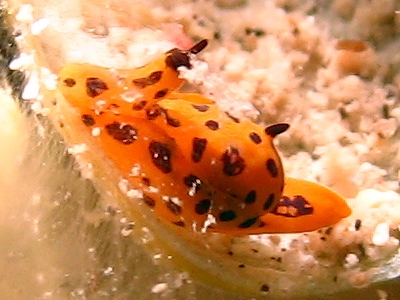
Concerning message #14792:
Dear Bill,
I'm sending you a new picture I took today, and I think it is Siphopteron michaeli.
Locality: Hermitage beach, 0,5 metre, Reunion Island, Indian Ocean, 29 october 2006. Length: 3 mm. Photographer: Hugues Flodrops.
It was very difficult to find it because of its size. Perhaps the substrate in the algae is its food and it may be a good place for hiding.
Best regards.
Hugues.
hugues.flodrops@wanadoo.fr
Flodrops.H, 2006 (Nov 7) Siphopteron michaeli from Reunion Island. [Message in] Sea Slug Forum. Australian Museum, Sydney. Available from http://www.seaslugforum.net/find/18157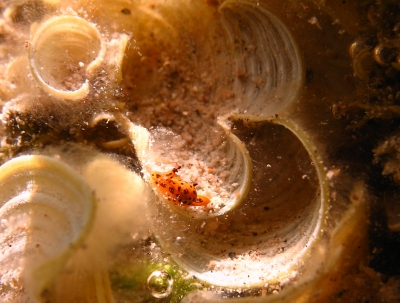
Dear Hugues,
Thanks for the photo. I think the algae it is on is a species of Padina. The white layers you can see are bands of calcification and I am pretty sure that Padina is the only genus of brown algae that has a calcified skeleton like this. It is certainly possible that there are some small animals living in the algae which Siphopteron feeds on. Unfortunately we seem to have no clues on what they are!
Best wishes,
Bill Rudman
Siphopteron not Gastropteron michaeli
September 23, 2005
From: Philibert Bidgrain
Dear Bill,
Re: your question about Siphopteron or Gastropteron michaeli.[#14792] It's a long story without solution... When I found this species in Docteur Jay's collection, I had some problems because I couldn't discover any informations in books , publications , your forum and other seaslug site ( Robert Bolland , Mike Miller Erwin Koehler, ...)
Two month ago, I found in "Museum d'Histoire Naturelle de Paris" Gosliner's publication about this species....
For confirmation , I send this photo to Terry Gosliner. He answer that : "This is indeed what we now call Siphopteron michaeli. It is known only from La Reunion. I also have photos of the animal that I photographed when I visited Le reunion many years ago. it is quite common in shallow water under coral heads, inside the barrier reef"
So if somebody have more informations...
Best Regards
Philibert Bidgrain
http://vieoceane.free.fr/runseaslug/indexslug.htm
vieoceane@free.fr
Bidgrain, P., 2005 (Sep 23) Siphopteron not Gastropteron michaeli. [Message in] Sea Slug Forum. Australian Museum, Sydney. Available from http://www.seaslugforum.net/find/14825Dear Philibert,
Thanks for that. My mistake! I thought Terry described Gastropteron michaeli the year after his revision in which he described the genus Siphopteron, but G. michaeli was actually described the year before, and moved to Siphopteron in that revision. So the 'long story' does have an easy solution - your animal is indeed a species of Siphopteron.
The only external difference between the genera is that in Siphopteron there is a crest or sometimes a central rod, protruding from the end of the siphon at the posterior end of the head-shield, but sometimes it isnot that easy to see. There are however characteristic differences in the radular morphology, and reproductive system. I have changed the name on the Fact Sheet
Best wishes,
Bill Rudman
Gastropteron michaeli from Reunion Is., Indian Ocean
September 19, 2005
From: P. Bidgrain

Dear Bill,
Reunion Island sea slugs.
This specimen (size 3 mm) of Siphopteron michaeli was found by Maurice Jay under a rock in the lagoon. This species was described by T. Gosliner from Reunion Island.
Locality: Grand fond lagoon, Reunion Island, Indian Ocean. Depth: 50 cm. Length: 3 mm. under dead coral. Photographer: Maurice Jay
Best Regards
Philibert Bidgrain
http://vieoceane.free.fr/runseaslug/indexslug.htm
vieoceane@free.fr
Bidgrain, P., 2005 (Sep 19) Gastropteron michaeli from Reunion Is., Indian Ocean. [Message in] Sea Slug Forum. Australian Museum, Sydney. Available from http://www.seaslugforum.net/find/14792Note added 23 Sept 2005: Gosliner, 1989 moved this species to Siphopteron.
Dear Philibert,
Thanks for this record and photo of Gastropteron michaeli. I am not sure why you have placed it in Siphopteron. I haven't seen any publication suggesting it should be moved from Gastropteron. We know so little about this species that any new information is valuable.
Best wishes,
Bill Rudman
